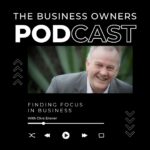Small business owners are often under pressure to generate income, create and grow profitable businesses, hire and support employees, and to drive economic growth for their communities. Owning, running and growing a small business is no small feat. The past few years alone would have been challenging for any business owner, with inflation and ongoing COVID-related issues.
In a new survey by ANZ, Australian small business owners say the top three hurdles they have successfully overcome in the first few years of operation were: adapting to COVID-19 related disruptions (such as lockdowns and restrictions); cash flow disruptions; and lack of growth opportunities.

Let’s pause on this last point for a second. Entrepreneurs often say times of great upheaval – for example a global pandemic –lead to greater opportunities for innovation, thinking laterally and capitalising on opportunities previously unseen.
The pandemic saw restaurants pivot to become dark kitchens with no storefront or seating areas, local distilleries began manufacturing alcohol-based hand sanitiser instead of gin, hotels even started offering day rates for work from home employees who ran out of space (or patience). So, is the issue really a lack of opportunities, or instead, is it knowing how and when to pounce?
In our survey, nearly one in five Australian small business owners listed “not knowing how to take the next step” as a key barrier impacting business growth.
But knowing how valuable small business is to the Australian economy – they account for more than 97% of all Australian businesses and 32% of our total GDP – it’s in our interest not just as a bank, but as an economy, for us to equip the next generation of small business thinkers, doers and entrepreneurs with the right tools to focus on growth. So here are three indicators you are ready to take the next step:
You have a clear picture of where you are at financially
It’s no secret that a key to business growth is having your finances in order, so you’re financially ready today, for what’s coming tomorrow, and can also weather the unexpected. Having a solid grasp of your business’ financial position, good financial practices, and the right systems in place is crucial.
An up-to-date balance sheet will help you identify things like whether you’re making enough money to pay for future expenses and whether your business is growing or declining. Your profit and loss statement is a valuable forecasting tool to identify opportunities for cost savings and areas to invest in. Lastly, a cash flow statement will help you to anticipate costs and identify trends so you can plan for the future.
You can see the bigger picture
It’s easy to get so caught up in the day-to-day running of your business that you lose sight of larger objectives. But as a small business owner, take time to think strategically to make sure you’re heading in the right direction.
This starts with analysing and clearly stating your current position: have you done a SWOT analysis (Strengths, Weaknesses, Opportunities, Threats)? Do you have a marketing plan? And a good grasp of the external factors that impact your business?
Next, decide what you’d like the business to look like, setting specific targets and timeframes. For example, your current market share might be 10% and your profit margin might be 34%. You might decide to grow your market share to 20% and increase your gross profit margin to 40% within three years.
You’re ready to take on debt
Whether growth for you means opening new premises, taking on a freehold or upgrading equipment, you’ll likely need capital for it. If you’ve decided you need to access more funds for your business, you can save valuable time by being one step ahead and knowing what potential lenders will be looking for in your loan application.
At ANZ we talk about the four Cs of credit:
- Character – your business acumen, reputation, credit history and track record of repaying debt.
- Capacity – your ability to repay the debt.
- Collateral – an item or asset of value typically used to secure the loan, such as cash, property, land or accounts receivable.
- Capital – a lender looks at a borrower’s capital as part of checking what assets the borrower has available, if they’re needed to help make repayments on the loan.
When applying for a loan, it is important to be informed, prepared and in good shape to borrow.
Helping Australian small business owners to be financially ready for the ups and downs of business, means ensuring they are ready for today, but importantly, ready for tomorrow, and able to identify and capitalise on opportunities as they come.
ANZ developed the ANZ Financially Ready Business Hub, with articles, templates and planners to support small business owners to make decisions about accelerating their business plans and be financially ready to take their next step. A personalised one-on-one session with an Business Banker can help you get on top of your money today, plan for the unexpected and pursue your goals for tomorrow.





















